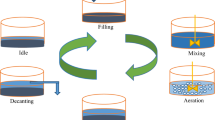Abstract
Aeration of the biological reactor in wastewater treatment plants (WWTPs) represents one of the major cost items, which may account for more than 50% of the total energy consumption. Therefore, airflow rate must be supplied based on the real needs of the biological reactions and the goals to be achieved in terms of removal efficiency and effluent quality. Among the different strategies available to optimize energy consumption of air supply, the Oxy Fuzzy logic and oxidation reduction potential (ORP)-based control systems have proven to be efficient and reliable. The present study compares the effects of these two control systems in terms of energy consumption and efficiency of COD and ammonia oxidation in the activated sludge reactors of two WWTPs for domestic sewage. Both systems allowed to largely comply with the limits set on the effluent for COD and ammonia in spite of the dynamic pattern of the influent load. The Oxy Fuzzy system led to reducing energy consumption by 13% while the ORP control system only by 2%, as average per year. The Oxy Fuzzy system showed higher flexibility, being more capable of adapting the set-points in relation to the influent load. The ORP system seemed to be more suitable for plants where the influent load does not change significantly: the set-points are fixed and the input load can be properly managed only for limited variations.









Similar content being viewed by others
References
Akerkar, R. A., & Sajja, P. S. (2009). Knowledge-based systems. Sudbury: Jones & Bartlett Publishers.
APHA, AWWA, & WEF. (2005). Standard methods for the examination of water and wastewater (21st ed.) Washington, DC: American Public Health Association/American Water Works Association.
Beccari, M., Passino, R., Ramadori, R., & Vismara, R. (1997). Rimozione di azoto e fosforo dai liquami, ed. Italia: Hoepli ISBN 88-203-1968-3 (in Italian).
Belchior, C. A. C., Araújo, R. A. M., & Landeck, J. A. C. (2012). Dissolved oxygen control of the activated sludge wastewater treatment process using stable adaptive fuzzy control. Computers and Chemical Engineering, 37, 152–162.
Benetto, E., Dujet, C., & Rousseaux, P. (2008). Integrating fuzzy multicriteria analysis and uncertainty evaluation in life cycle assessment. Environmental Modelling and Software, 23(12), 1461–1467.
Chang, C. N., Cheng, H. B., & Chao, A. C. (2004). Applying the Nernst equation to simulate redox potential variations for biological nitrification and denitrification processes. Environmental Science & Technology, 38(6), 1807–1812.
Fiter, M., Güell, D., Colprim, J., Poch, M., & Rodríguez-Roda, I. (2005). Energy saving in a wastewater treatment process: an application of fuzzy logic control. Environmental Technology, 26, 1263–1270.
Hao, O. J., & Huang, J. (1996). Alternating aerobic-anaerobic process for nitrogen removal: process evaluation. Water Environment Research, 68(1), 83–93.
Héduit, A., & Thevenot, D. R. (1989). Relation between redox potential and oxygen levels in activated-sludge reactors. Water Science and Technology, 21(8–9), 947–956.
ISPRA, Istituto superiore per la ricerca ambientale (2009) L’ottimizzazione del servizio di depurazione delle acque di scarico urbane: massimizzazione dei recuperi di risorsa (acque e fanghi) e riduzione dei consumi energetici, Rapporti 23/2009, Italia (in Italian).
Koch, F. A., & Oldham, W. K. (1985). Oxidation-reduction potential—a tool for monitoring, control and optimization of biological nutrient removal systems. Water Science and Technology, 17(11–12), 259–281.
Lindberg, C. F., & Carlsson, B. (1996). Nonlinear and set point control of the dissolved oxygen concentration in an activated sludge process. Water Science and Technology, 34, 135–142.
López, E. M., García, M., Schuhmacher, M., & Domingo, J. L. (2008). A fuzzy expert system for soil characterization. Environment International, 34(7), 950–958.
Martín de la Vega, P. T., Martínez de Salazar, E., Jaramillo, M. A., & Cros, J. (2012). New contributions to the ORP & DO time profile characterization to improve biological nutrient removal. Bioresource Technology, 114, 160–167.
Metcalf & Eddy, Tchobanoglous, G., Stensel, H. D., Tsuchihashi, R., & Burton, F. L. (2013). Wastewater engineering: treatment and resource recovery. New York: Mc Graw-Hill Education.
Santín, I., Pedret, C., & Vilanova, R. (2015). Applying variable dissolved oxygen set point in a two level hierarchical control structure to a wastewater treatment process. Journal of Process Control, 28, 40–55.
Vaccari, M., Foladori, P., & Campanelli, M. (2013). Consumi elettrici ed efficienza energetica del trattamento delle acque reflue. Italia: Maggioli ISBN 8838783683 (in Italian).
Wareham, D., Hall, K., & Mavinic, D. (1994). Real-time control of wastewater treatment systems using ORP. Water Science and Technology, 28(11–12), 273–282.
Author information
Authors and Affiliations
Corresponding author
Rights and permissions
About this article
Cite this article
Chiavola, A., Romano, R., Bongirolami, S. et al. Optimization of Energy Consumption in the Biological Reactor of a Wastewater Treatment Plant by Means of Oxy Fuzzy and ORP Control. Water Air Soil Pollut 228, 277 (2017). https://doi.org/10.1007/s11270-017-3462-x
Received:
Accepted:
Published:
DOI: https://doi.org/10.1007/s11270-017-3462-x




